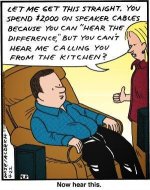I think wives consider the physical size of speakers to include not only the speaker itself but also all of the associated territory that is off-limits to other furnishings in order to enhance sound and maximize the sweet spot. On that basis my OB Linkwitz Orions indeed constrain more square footage than a sofa!
It's called a notch filter, it attenuates frequencies that are "shrill" to the ear.
Common examples are those frequencies emitted by pissed off women.
_______________________________________________Rick.........
Interestingly, females lose LF hearing with ageing, males lose HF hearing with ageing.....win/win situation.
Interestingly, females lose LF hearing with ageing, males lose HF hearing with ageing.....win/win situation.
Ah! so neither husband nor wife hears the other as we age. It's time to work on my Falsetto...
Interestingly, females lose LF hearing with ageing, males lose HF hearing with ageing.....win/win situation.
that means old women can throw their woofers in the trash and men their tweeters........just kidding
i have tinitus , on a bad day i loose hearing on high frequencies at least 50% , it´s worse in the morning but usualy goes away later in the day , glad it´s not everyday
Last edited:
Interestingly, females lose LF hearing with ageing, males lose HF hearing with ageing.....win/win situation.
That would be handy but is unfortunately incorrect.
It must be true...I read it in New ScientistThat would be handy but is unfortunately incorrect.
cicadas are much louder...
https://www.google.com/search?q=cic...urce=og&sa=N&tab=wi&ei=LvdOUuGqD8qJ0AWYj4CgCg
https://www.google.com/search?q=cic...urce=og&sa=N&tab=wi&ei=LvdOUuGqD8qJ0AWYj4CgCg
It must be true...I read it in New Scientist.
Given how our hearing works it can not be true.
In our cochlea are hair cells which are arranged roughly in 1/3 octave bands.
When only the first ones bend over from acoustical pressure we hear a high pitched tone and when all bend we hear a very low frequency one.
At the bottom of each hair is a tiny muscle which contracts to bring the hair upright again. With advancing age these muscles gradually fail to do that.
The ones which got bend over most often are the first to fail to do their job.
These are the high frequency ones.
It is not only the same in men and women, it is the same in all mammals.
so all I need is to exercise some buried tiny muscles to improve my age related uprightness - saves on those little blue or yellow pills ?
of course then the opportunity would need to "arise" as well
Courtesy of the
Hearing Foundation of Canada
Sound waves in the air are directed by the outer ear into the ear drum causing it to vibrate very slightly. The three bones of the middle ear (the smallest bones in the human body) work together as a lever system to amplify the vibrations as they pass them along to a smaller vibrating membrane on the surface of the cochlea of the inner ear. This vibration is passed on by the fluid filled spiral tube of the cochlea to tiny hair cells along the inside. As the hairs move, nerve cells at their base change this motion into electrical signals that are passed on to the brain. The brain in turn interprets those signals as sound.
Hearing loss or impairment can stem from a variety of problems, which can occur as sound is transferred along this mechanical and electrical paths to the brain. The causes can be as simple (and reversible) as wax build up or inflammation of the outer ear, or more serious yet often self-repairing broken eardrum, or even abnormal or dislocated bones of the middle ear.
Inner ear damage can be acquired from a short blast or repeated or prolonged exposure to loud noise (construction noise or a Walkman cranked up too loud). The delicate hairs in the cochlea can be irreparably destroyed. High frequency sounds are usually the first to go. Disease, infection or drugs can also damage the inner ear.
of course then the opportunity would need to "arise" as well
Courtesy of the
Hearing Foundation of Canada
Sound waves in the air are directed by the outer ear into the ear drum causing it to vibrate very slightly. The three bones of the middle ear (the smallest bones in the human body) work together as a lever system to amplify the vibrations as they pass them along to a smaller vibrating membrane on the surface of the cochlea of the inner ear. This vibration is passed on by the fluid filled spiral tube of the cochlea to tiny hair cells along the inside. As the hairs move, nerve cells at their base change this motion into electrical signals that are passed on to the brain. The brain in turn interprets those signals as sound.
Hearing loss or impairment can stem from a variety of problems, which can occur as sound is transferred along this mechanical and electrical paths to the brain. The causes can be as simple (and reversible) as wax build up or inflammation of the outer ear, or more serious yet often self-repairing broken eardrum, or even abnormal or dislocated bones of the middle ear.
Inner ear damage can be acquired from a short blast or repeated or prolonged exposure to loud noise (construction noise or a Walkman cranked up too loud). The delicate hairs in the cochlea can be irreparably destroyed. High frequency sounds are usually the first to go. Disease, infection or drugs can also damage the inner ear.
- Status
- This old topic is closed. If you want to reopen this topic, contact a moderator using the "Report Post" button.
- Home
- Member Areas
- The Lounge
- How true is this?

